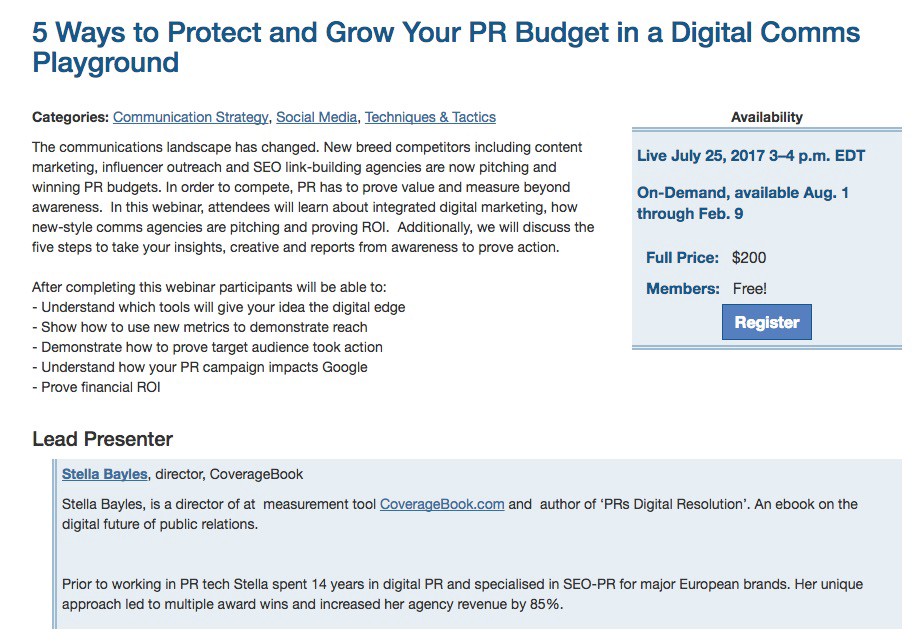There have never been so many new-breed agencies offering similar services. PR, influencer outreach, content marketing, link-builders, social and digital marketing set-ups are all winning communications briefs.
How can PR agencies compete?
With better measurement.
Today’s PR landscape is busy and complicated yet full of opportunity.
There are multiple lines of communication between brands and audience (just this week UK PR blogger Stephen Waddington outlined this). And with those new lines of communication come new ways to report and new metrics to consider.
And new-breed digital teams are nailing it.

Marketing directors put their budget where they can see a return. And ROI measurements of success are exactly how digital agencies are reporting. Simple top line reports demonstrating impact and money made.
It’s not just the head of marketing looking through these reports. Often top-line marketing performance is sent directly to the C-Suite and when I say top-line I mean it’s brief. The CEO is busy. They only have time to look at figures; what’s performing and what’s not. Very few have time to trawl through big books of copied and paste articles.
If your report doesn’t have a killer business-related metric it simply won’t get the attention of the budget holders and the people that matter.
To grow your PR budget this year or at the very least protect it, you must compete with the digital agencies and report on business impact.
Here are my three lessons in gaining the attention of the C-suite
Lesson 1. Measure beyond ‘awareness’
I’m fully aware that many PR briefs simply require you to ‘raise awareness’ but there will always be a reason behind this request.
It may be to ‘raise awareness of a charity to gain more donations’ or ‘raise awareness to sell more shoes’ or ‘raise awareness to gain more votes’. There will always be an underlying objective and you need to clarify it upfront so you can organise your measurement accordingly.
Measuring awareness raised is still a very important part of Public Relations reporting however its just one part.
Public Relations measurement should include;
- The output of the campaign: The awareness raised among our target audience
- The outcome of the campaign: The action our target audience took

Whether you’re using unique users, visitors, coverage views or reach to track your coverage you’re doing one thing; reporting on article success and awareness.
No matter how accurate your coverage data is it won’t tell you whether you have met the objective your client set for the overall campaign. To do this you need to track additional campaign-specific metrics, review the action taken by your target audience and evaluate.
Lesson 2. Have one killer stat
As previously mentioned the C-Suite are busy. If they open a PR report email they’ll probably have time to read the first sentence. That’s why you need to impress in seconds.
We know that senior stakeholders often like to see financial increases and wins but don’t let this draw you to using ‘advertising value equivalent’ in your measurement. Firstly, it doesn’t actually tell anyone if your communications were successful and secondly it will just remind your reader to check how the advertising team are doing.
Instead look into real numbers. Did your coverage include a link to your client’s website? Does your client’s website sell products or offer downloadable content? Find out how your work affected this.
If you increased traffic, downloads of a whitepaper or sales this is the kind of data the C-Suite wants to know. Gain access to your client’s analytics to review this information. If you find Google Analytics confusing to begin with, use free tool http://answertheclient.com/ to help get you started.
Lesson 3. Introduce overview reporting
PR Measurement shouldn’t end with the campaign report. Often the full effect of your coverage won’t take place until some time after your campaign.
Sure, people may read an article as soon as your coverage goes live but earned natural shares of that article means others may not read and interact with the article until some weeks after the go-live date.
It’s important to return to past campaigns and check how your results are months after the campaign. You’ll often find that social shares have gone up, reach has increased and more traffic was delivered to your client’s content.
Reporting on overall results throughout the year will not only give you a clearer picture of your success it will also allow you to compare to past campaigns. You can see if the idea worked, made a difference and then improve for next time.
Activity — Measure — Evaluate — Insights
Objectives, KPIs and metrics may differ from one campaign to the next so it’s key to have some consistent metrics throughout all campaigns so you can track performance over time.
The insights that you will pull and overview stats are the kind of results senior stakeholders care about. Look for monthly or year on year increases in data. Your killer stat needs to have business relevance, demonstrate impact and be a direct result of your work.
If you nail my three lessons you’ll not only be competing with the digital agencies you’ll be gaining the attention of the C-Suite. and when the attention is won your budget is safe and you path is laid to grow that relationship and grow your budget. Good luck!
If you want to learn more about the new digital comms competitors and how to deliver business impact join me on my live webinar with the PRSA on July 25th 2017.
I’ll be revealing how you can prove your PR campaigns had a positive financial impact to your clients and there won’t be an AVE sum in sight!
Sign up here.
